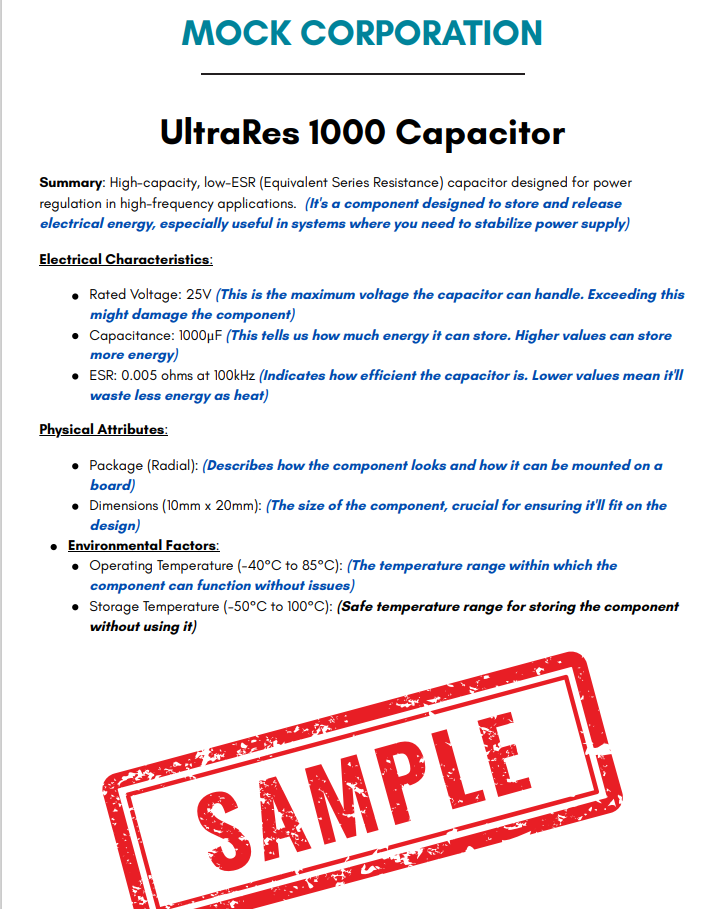In the complex ecosystem of electronics manufacturing and design, component specifications and datasheets stand out as essential tools for procurement professionals. These documents, often packed with intricate technical details, provide a window into electronic components’ capabilities, functionalities, and limitations. But why are these details crucial for those in procurement? Let’s dive into it.
The Essence of Component Specifications & Datasheets
At their core, component specifications and datasheets are technical documents provided by manufacturers to describe the performance and properties of their products. These can range from passive components like resistors and capacitors to more complex integrated circuits.
The datasheet typically includes:
- Physical attributes: Dimensions, pin configurations, and package types.
- Electrical characteristics: Operating voltages, current ratings, and power dissipation.
- Performance metrics: Speed, bandwidth, and efficiency.
- Environmental factors: Operating temperature ranges and storage conditions.
- Compatibility and interfacing details: Logic levels and connection diagrams.
The Procurement Perspective: Why Care?
For procurement professionals, understanding these documents is pivotal for several reasons:
- Ensuring Compatibility: The success of an electronics product hinges on the flawless integration of its components. Procurement professionals must ensure the components they source are compatible with the design requirements.
- Risk Mitigation: Understanding the operating and storage conditions from datasheets helps prevent premature component failures by ensuring they are used within their specified limits.
- Cost Efficiency: Some components may come with additional features or superior performance metrics that may not always be necessary for a particular application. Recognizing these can avoid overspending on over-specified parts.
- Communication with Engineers: Being conversant with datasheets fosters more transparent communication with design and quality engineers, ensuring that the procured components align with the project’s technical needs.
Tips for Navigating Datasheets
Start with the Summary: Many datasheets begin with a summary of the component’s features and applications. This offers a quick overview and can guide whether the component is a potential fit.
Look for Absolute Maximum Ratings: This section provides limits beyond which the component might suffer irreversible damage. It’s vital for assessing the component’s robustness and reliability.
Check for Reference Designs: Some datasheets include reference circuit designs or typical application circuits, which can be beneficial for understanding the component’s real-world applications.
Stay Updated: Manufacturers sometimes update datasheets to reflect component changes or provide additional data. Ensure you’re referencing the most recent version.
BREAKING IT DOWN WITH A MOCK DATASHEET
See below an example of a datasheet followed by the meaning of each line as it pertains to a procurement pro’s job. For a procurement professional, understanding these datasheet terms can help ensure that the components they source will be fit for purpose, compatible with the design, and cost-effective. While they don’t need to delve into the deepest technical details, a basic grasp helps make informed decisions and communicate effectively with the technical teams.

Challenges and Solutions
Challenge: Datasheets can be lengthy and densely packed with information.
Solution: Focus on the sections most relevant to the application. Use bookmarks and annotations to reference vital details quickly.
Challenge: Different manufacturers might present data differently.
Solution: Familiarize yourself with multiple formats. Over time, recognizing the patterns in how information is presented becomes second nature.
For procurement pros in the electronics industry, diving deep into component specifications and datasheets isn’t just a technical necessity—it’s a strategic move. It ensures product compatibility, cost efficiency, risk mitigation, and effective collaboration with technical teams. So, the next time a complex datasheet lands on your desk, view it as an opportunity, not an obstacle.

